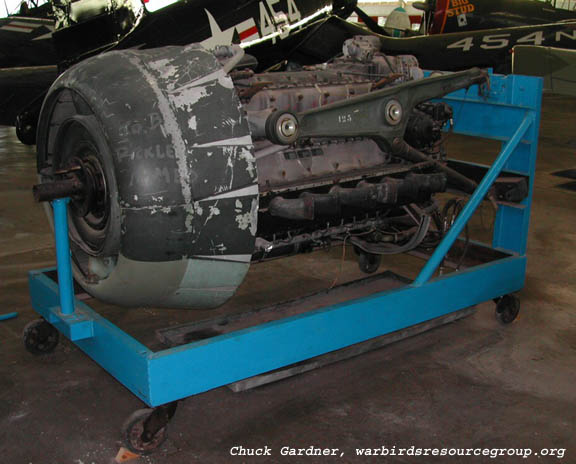    |
 |
Junkers Jumo 213

(Specifications for Jumo 213E)
|
General: Manufacturer: Junkers Type: Supercharged liquid-cooled inverted Vee piston engine Cylinders: 12 Bore: 150 mm (5.9 in) Stroke: 165 mm (6.5 in) Displacement: 35 L (2,135 in³) Length: 2,266 mm (89.2 in) Dry weight: 940 kg (2,072 lb) Components: Valvetrain: Three valves per cylinder. Supercharger: Two-stage two-speed centrifugal type supercharger with MW50 injection into the intake and an aftercooler. Cooling system: Pressurized water up to 120°C (248°F) Performance: Power output: – 1,287 kW (1,725 hp) at 3,250 rpm for takeoff; rated altitude 9,600 m (31,500 ft) – 1,508 kW (2,020 hp) for takeoff with MW50 injection Specific power: 36.8 kW/L (0.81 hp/in³) Compression ratio: 6.5:1 (B4 fuel, 87 octane) Power-to-weight ratio: 1.37 kW/kg (0.83 hp/lb) |
Power output: – 645 kW (865 hp) at sea level – 716 kW (960 hp) at 3,000 m (9,850 ft) at 2,450 rpm Specific power: 25.8 kW/L (0.57 hp/in³) Compression ratio: 6.93:1 Specific fuel consumption: 0.33 kg/(kW·h) (0.54 lb/(hp·h)) Power-to-weight ratio: 1.36 kW/kg (0.83 hp/lb) 
|
|
Comments - Source: Wikipedia The Jumo 213 was a World War II-era V-12 liquid cooled aircraft engine, a development of Junkers Motoren's earlier design, the Jumo 211. The design added two features, a pressurized cooling system that required considerably less cooling fluid that allowed the engine to be built smaller and lighter, and a number of improvements that allowed it to run at higher RPM. Although these changes may sound fairly minor, they boosted power by over 500 hp and made the 213 one of the most sought-after engine designs in the late-war era. When the Jumo 211 entered production in the late 1930s it used a normal liquid cooling system based on an "open cycle". Water was pumped through the engine to keep it cool, but the system as a whole operated at outside air pressure, or only slightly greater. Since the boiling point of water is effected by pressure, this meant that as the aircraft climbed the temperature of the cooling water had to be kept quite low to avoid boiling, which in turn meant that the water removed little heat from the engine before having to be moved to the radiator to cool it. In contrast, the Daimler-Benz DB 601 used a pressurized system that ran at the same increased pressure at all altitudes, raising the boiling point to about 110°C. This allowed it to use considerably less water for the same amount of cooling power, and it retained this power at all altitudes. Although otherwise similar in most respects, the 601 was smaller and lighter than the 211 and could be run at higher power settings at higher altitudes, making it popular in fighter designs. The 211 was relegated to "secondary" roles in bombers and transports. Junkers was not happy with this state of affairs, and started their own efforts to produce a pressurized cooling system as early as 1938. Experiments on the 211 proved so successful that it became clear that not only could the engine be built smaller, but could be run at higher power settings without overheating. Additional changes to strengthen the crankshaft and add a fully-shrouded supercharger for increased boost resulted in the Jumo 211F model, which delivered 1,400 hp at 2,400 RPM, up from 950 hp at 2,200 RPM in earlier versions. But this was only the beginning. After redesigning the engine casing to a smaller size to suit the increased cooling power and then further increasing boost settings on the supercharger, the resulting 213A model was able to deliver 1,750 PS (metric hp) at 3,250 RPM. This made it considerably more powerful than the corresponding DB 601E which provided 1,350hp, and about the same power as the much larger DB 603. Junkers decided to go after the 603's market, and made the 213's mounting points and fluid connections in the same locations as the 603, allowing it to be "dropped in" as a replacement. The 213A first ran in 1940, but experienced lengthy delays before finally being declared "production quality" in 1943. Production was extremely slow to ramp up, in order to avoid delays in the existing Jumo 211 production. By the time the engines were available in any sort of number in 1944, Allied bombing repeatedly destroyed the production lines. Production of the A models was limited to about 400-500 a month for most of 1944/45. A range of advanced versions were also developed during the lengthy teething period. The 213B was designed to run on 100 octane "C3" fuel, allowing the boost pressure to be increased and the take-off power improved to 2,000 PS. The 213C was essentially an A model with re-arranged secondary equipment (supercharger, oil pump, etc.) to allow a cannon to fire through the propeller shaft. The 213D added a new three-speed supercharger for smoother power curves and improved altitude performance, but it was decided to skip over this version. Instead the next major version was to be the 213E, and the similar 213F. These engines were equipped with a new two-speed, two-stage supercharger that dramatically improved altitude performance. The only difference between the two models was that the E included an intercooler for additional high-altitude performance, while the F model removed this and was tuned for slightly lower altitudes. The E and F models were in high demand for many late-war aircraft, including the Junkers Ju 188, Junkers Ju 388, models of the Focke-Wulf Fw 190 and the Focke-Wulf Ta 152H. A more major upgrade was projected as the 213J, which replaced the earlier model's three valves with a new four-valve-per-cylinder design for increased volumetric efficiency. There was no time to work this change into the production line before the war ended. Other experimental models included the 213S for low-altitude use, and the turbocharged 213T. |
 |
 |
 |
